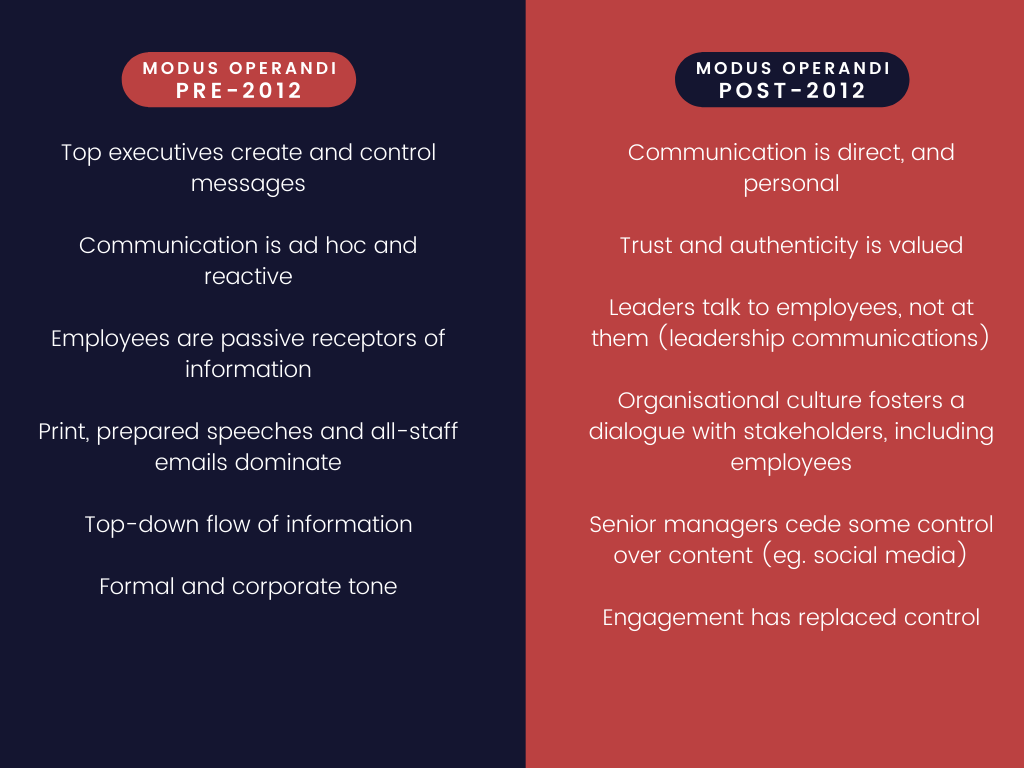Internal Communications
Across Asia Pacific the internal communications discipline is managed most frequently in the integrated corporate public affairs management function (80 per cent in Australia according to the Centre’s 2019 – 2020 State of Public Affairs in Australia).
When internal communications is not managed in corporate public affairs it is most frequently managed in the human resources/people management function.
The Centre has a strong view, supported by the experience of many corporations, that where management accountability for internal communications has moved from corporate public affairs to human resources, the discipline suffers from not being managed with other socio-political disciplines.
The intellectual framework and practice of communications, engagement, and advocacy that underpins and intersects good internal communication as a co-producer and keeper of the corporate narrative, is very different from the core focus of the human resources management function (payroll, policies, procedures, development).
The evolution of the internal communications discipline in large organisations is outlined in the following Exhibit.

Until the early years of this Century, while perceived as a necessary and useful capability in the corporate setting, the internal communications discipline did not enjoy the same profile or importance as media relations or government relations.
Today, internal communications is one element of the holy trinity of contemporary corporate affairs disciplines, joining external/stakeholder relations and government relations.
At its best, the discipline interprets the external environment and the socio-political environment for the organisation (the ‘window in’), and supports the organisation’s employees to embrace internal values and the corporate narrative, and understand what they need to do to contribute to the organisation realising its strategy.
Between 10 per cent to 15 per cent of full-time employees in corporate public affairs teams in corporations operating in Australia work in internal communications (2019 – 2020 State of Public Affairs in Australia); the figure across the rest of the Asia Pacific is between 10 per cent and 20 per cent.
The internal communications discipline typically works across the organisation, its divisions, and business units. In this sense, it is a ‘boundary rider’, needing to understand the whole organisation and its operations.
At the beginning of the second decade of the 21st Century, the internal communications discipline is at the centre of significant organisational change management and transformation efforts (best practice is that to be effective, big change programs are senior executive leadership team-led, and characterised by authentic, frequent, communications), and central to organisational culture change and extension.
Modern and best practice internal communication strategy and tactics is informed by workplace psychology, workplace anthropology, heuristics, and data analytics – a far cry from perceptions, that still exist in some organisations to this day, that internal communications is about inspirational posters in workplace kitchens, and writing all-employee emails for managers.
Internal communications has been morphing into ‘employee communications’ for some time, engaging with internal communications tools and channels to engage employees, as well as external channels with which employees engage also.
Many corporations considered best practice are approaching employee and external communications as stakeholder communications, characterised by communication practitioners executing internal and external communications strategy. This has been a significant development since 2016.
Other notable developments in the discipline include:
- industrialisation of the discipline – content generator/producer for the corporate public affairs function;
- co-producer and keeper of the corporate narrative;
- strengthened capability as an advocacy campaigner;
- evolution of the discipline to lead change management;
- emergent role in crisis management; and
- the embrace of research and data.
Related resources from the Centre's Knowlede Centre...
Technostress and Commitment to Change: The Moderating Role of Internal Communication
This study assesses the moderating role of internal communication in the technostress and commitment to change relationship. Internal communication was found to moderate the relationship between techno-uncertainty and...
NEWS-DIGESTExplore the Centre’s Knowledge Centre
Browse more Internal Communications resources in the Knowledge Centre.
